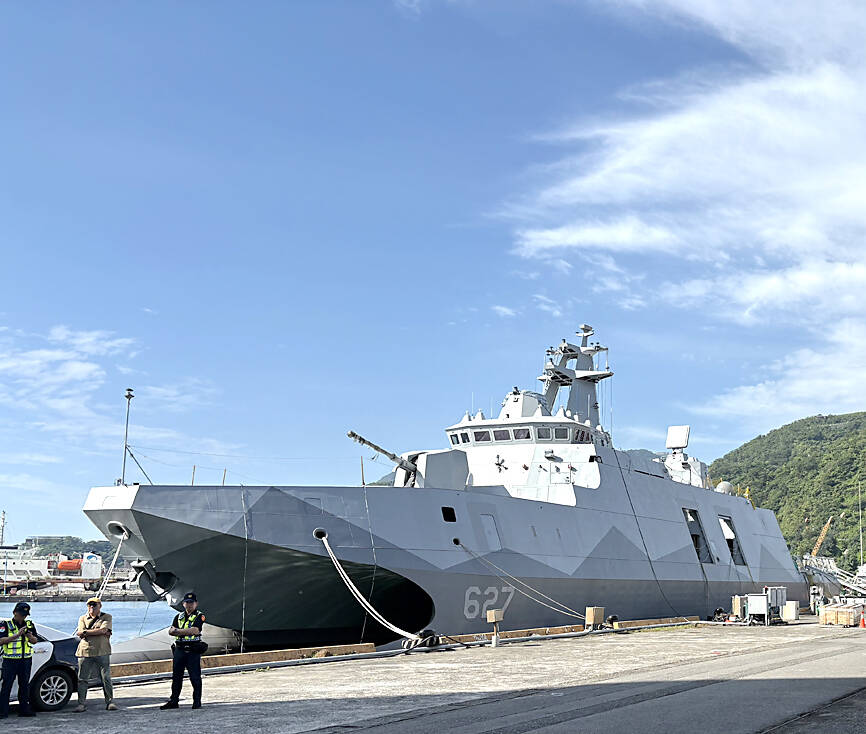The first of the remaining five Tuo Chiang-class stealth missile corvettes being domestically built for the navy was officially launched in a ceremony presided over by navy commander Admiral Tang Hua (唐華) on Wednesday, according to an anonymous military source.
The Dan Chiang (丹江, PGG-627) was launched in a ceremony that was closed to the press, with the newly constructed ship officially entering the water for the first time. The vessel was also christened, according to the source.
The corvette, named after the Danda River (丹大溪) in central Nantou County, is expected to be delivered to the navy next year after further trials, the unnamed source added.

Photo: CNA
Tuo Chiang is a domestically designed and manufactured class of fast and stealthy multipurpose corvette built for the navy.
In addition to the prototype — the Tuo Chiang (沱江, PGG-618), which was commissioned in 2015 — the first batch consisting of six corvettes have all been delivered to the navy and entered service.
The Dan Chiang is the first of the second batch of five corvettes that are to be delivered to the navy, which would have 11 Tuo Chiang-class corvettes by the end of next year.
The Tuo Chiang-class corvette, which has a wave-piercing catamaran design, and is 60.4m long and 14m wide, has a top speed of 30 knots (55.6kph) and a range of 1,800 nautical miles (3,334km), the navy said.
The corvettes are fitted with subsonic Hsiung Feng II (雄風二, Brave Wind II) missiles, supersonic Hsiung Feng III (雄風三, Brave Wind III) anti-ship missiles, a 76mm cannon and Hai Chien II (海劍二, Sea Sword II) ship-based medium-range air defense missiles, enabling it to hit air and sea targets simultaneously, according to the navy.

A strong continental cold air mass is to bring pollutants to Taiwan from tomorrow, the Ministry of Environment said today, as it issued an “orange” air quality alert for most of the country. All of Taiwan except for Hualien and Taitung counties is to be under an “orange” air quality alert tomorrow, indicating air quality that is unhealthy for sensitive groups. In China, areas from Shandong to Shanghai have been enveloped in haze since Saturday, the ministry said in a news release. Yesterday, hourly concentrations of PM2.5 in these areas ranged from 65 to 160 micrograms per cubic meter (mg/m³), and pollutants were

Taiwan’s armed forces have established response protocols for a wide range of sudden contingencies, including the “Wan Chun Plan” to protect the head of state, the Ministry of Defense (MND) said today. After US President Donald Trump on Saturday launched a series of airstrikes in Venezuela and kidnapped Venezuelan President Nicolas Maduro, concerns have been raised as to whether China would launch a similar “decapitation strike” on Taiwan. The armed forces regularly coordinate with relevant agencies and practice drills to ensure preparedness for a wide range of scenarios, Vice Minister of National Defense Hsu Szu-chien (徐斯儉) told reporters before a

EVA Airways on Saturday said that it had suspended a pilot and opened an investigation after he allegedly lost his temper and punched the first officer several times as their plane was taxiing before takeoff at Los Angeles International Airport. According to a report published on Thursday by The Reporter, the incident occurred after the flight’s Malaysian first officer tried to warn the Taiwanese pilot, surnamed Wen (文), that he was taxiing faster than the speed limit of 30 knots (55.6kph). After alerting the pilot several times without response, the first officer manually applied the brakes in accordance with standard operating

NOT AN OPENING: Trump’s violation of international law does not affect China’s consideration in attacking Taiwan; Beijing lacks capability, not precedent, an official said Taiwanese officials see the US’ capture of the president of Venezuela as a powerful deterrent to Beijing’s aggression and a timely reminder of the US’ ability to defeat militaries equipped with Chinese-made weapons. The strikes that toppled Venezuelan President Nicolas Maduro signaled to authoritarian leaders, including Chinese President Xi Jinping (習近平), US President Donald Trump’s willingness to use military might for international affairs core to US interests, one senior official in Taipei’s security circle said. That reassured Taiwan, the person said. Taipei has also dismissed the idea that Trump’s apparent violation of international law could embolden Beijing, said the official, who was not